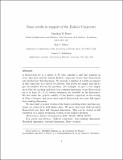Files in this item
Some results in support of the Kakeya conjecture
Item metadata
| dc.contributor.author | Fraser, Jonathan MacDonald | |
| dc.contributor.author | Olson, Eric | |
| dc.contributor.author | Robinson, James | |
| dc.date.accessioned | 2019-03-01T09:30:21Z | |
| dc.date.available | 2019-03-01T09:30:21Z | |
| dc.date.issued | 2017-10-01 | |
| dc.identifier | 249921410 | |
| dc.identifier | 4eacb186-44fa-4142-a5b1-a6cb6addec4f | |
| dc.identifier | 85041600211 | |
| dc.identifier | 000431996500002 | |
| dc.identifier.citation | Fraser , J M , Olson , E & Robinson , J 2017 , ' Some results in support of the Kakeya conjecture ' , Real Analysis Exchange , vol. 42 , no. 2 , pp. 253-268 . https://doi.org/10.14321/realanalexch.42.2.0253 | en |
| dc.identifier.issn | 0147-1937 | |
| dc.identifier.other | ORCID: /0000-0002-8066-9120/work/58285479 | |
| dc.identifier.uri | https://hdl.handle.net/10023/17184 | |
| dc.description | JMF was supported by the EPSRC grant EP/J013560/1 when at the University of Warwick and by the Leverhulme Trust Research Fellowship RF-2016-500 when at the University of St Andrews (current). | en |
| dc.description.abstract | A Besicovitch set is a subset of Rd that contains a unit line segment in every direction and the famous Kakeya conjecture states that Besicovitch sets should have full dimension. We provide a number of results in support of this conjecture in a variety of contexts. Our proofs are simple and aim to give an intuitive feel for the problem. For example, we give a very simple proof that the packing and lower box-counting dimension of any Besicovitch set is at least (d+1)/2 (better estimates are available in the literature). We also study the 'generic validity' of the Kakeya conjecture in the setting of Baire Category and prove that typical Besicovitch sets have full upper box-counting dimension. We also study a weaker version of the Kakeya problem where unit line segments are replaced by half-infinite lines. We prove that such 'half-extended Besicovitch sets' have full Assouad dimension. This can be viewed as full resolution of a (much weakened) version of the Kakeya problem. | |
| dc.format.extent | 316576 | |
| dc.language.iso | eng | |
| dc.relation.ispartof | Real Analysis Exchange | en |
| dc.subject | Kakeya conjecture | en |
| dc.subject | box counting dimension | en |
| dc.subject | Hausdorff dimension | en |
| dc.subject | Assouad dimension | en |
| dc.subject | Baire category | en |
| dc.subject | QA Mathematics | en |
| dc.subject | T-NDAS | en |
| dc.subject.lcc | QA | en |
| dc.title | Some results in support of the Kakeya conjecture | en |
| dc.type | Journal article | en |
| dc.contributor.sponsor | The Leverhulme Trust | en |
| dc.contributor.institution | University of St Andrews. Pure Mathematics | en |
| dc.identifier.doi | 10.14321/realanalexch.42.2.0253 | |
| dc.description.status | Peer reviewed | en |
| dc.date.embargoedUntil | 2018-10-01 | |
| dc.identifier.url | https://arxiv.org/abs/1407.6689 | en |
| dc.identifier.grantnumber | RF-2016-500 | en |
This item appears in the following Collection(s)
Items in the St Andrews Research Repository are protected by copyright, with all rights reserved, unless otherwise indicated.

